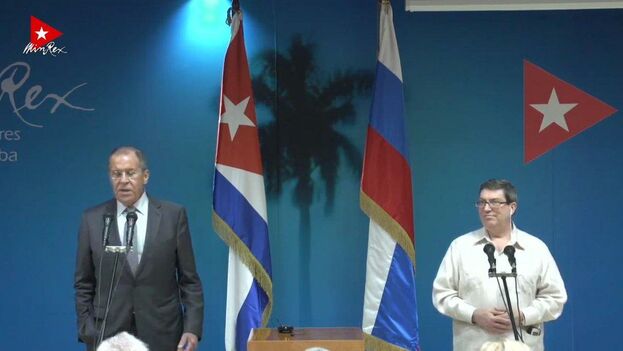
![]() 14ymedio, Havana, July 24, 2019 — Russia isn’t waiting time. Foreign Minister Sergey Lavrov’s tour through Latin America, which began this Tuesday with his arrival in Havana, sent the clear message that the old ally maintains with the Island a “deep agreement on the international agenda,” said the Minister of Foreign Relations, Bruno Rodríguez, during a press conference this Wednesday.
14ymedio, Havana, July 24, 2019 — Russia isn’t waiting time. Foreign Minister Sergey Lavrov’s tour through Latin America, which began this Tuesday with his arrival in Havana, sent the clear message that the old ally maintains with the Island a “deep agreement on the international agenda,” said the Minister of Foreign Relations, Bruno Rodríguez, during a press conference this Wednesday.
The minister’s visit happens at a moment of special financial tension for Cuba, and Lavrov has emphasized that Russia will contribute to “making the Cuban economy more sustainable in face of the blows,” alluding to the new restrictions imposed by the Administration of the United States.
Lavrov has also confirmed his backing of the senior leadership of the country, after more than a year of Miguel Díaz-Canel’s presidency. “We are going to continue supporting the Cuban leaders,” emphasized the diplomat, who met this Wednesday morning with his Cuban counterpart at the Ministry of Foreign Affairs headquarters.
During the meeting, Lavrov mentioned the joint economic projects that are in development, which “make progress in a sustainable way in strategic sectors like energy, industry, and transport,” according to a note in the official newspaper Granma. The minister stressed that Russia has in Cuba a “trustworthy and long-standing” partner.
For three decades Moscow supported the Cuban economy via subsidies and sugar purchases for which, on occasion, the Soviets ended up paying seven times above its cost on the world market. Of the 31.7 billion debt that the Island incurred, it only payed 500 million and Russia canceled the rest.
Recently, the economist Carmelo Mesa-Lago detailed that “the Soviet Union gave Cuba, in 30 years from 1960 to 1990, some $65 billion,” but despite that, the Island “didn’t change its structure and its system to be able to grow and finance imports. The money practically vanished.”
Last October Cuba and Russia signed seven agreements for collaboration in areas like the steel industry, sports, and customs services, at the same time opting to strengthen bilateral collaboration, commerce, and investments on the Island.
Railway is one of the sectors where the relationship between both countries has been the most palpable. Russia is carrying out an ambitious renovation project of the Cuban rail network, affected by decades of technical deterioration and lack of investment.
In June the director of the Russian company Sinara Transport Machines (STM), Anton Zubijin, said that projects of that type on the Island add up to 200 million Euros. “We have already covered half of the way, we’re providing 45 locomotives, and we are building together a locomotive repair factory,” he explained.
However, it is the collaboration in the military sphere that has gotten more international attention, especially from the United States. At the end of 2018 it was made known that the Cuban Government will receive a Russian credit of $50 million that will allow it to buy all types of arms and military material from Moscow.
Cuban authorities are seeking to modernize the military industry and armaments through the purchase of Russian tanks and armored vehicles, in addition to ships, spare parts, tools, and accessories.

Raúl Castro Ruz, first secretary of the Communist Party of Cuba, accompanied Lavrov to the inauguration ceremony for the restoration of the Statue of the Republic at the National Capitol. Russian experts were the ones in charge of the rehabilitation process of this sculpture and are putting gold plating on the dome of the emblematic building.
The restored sculpture is the work of the Italian artist Angelo Zanelli and it is considered the third tallest statue underneath a roof in the world.
Although so far no official reference has been made to the situation in Venezuela, Lavrov’s arrival in Cuba also coincides with the dialogue process between the regime of Nicolás Maduro and representatives of the opposition which is being held in Barbados, on which Russian influence has projected several times.
This Tuesday Lavrov told the press that “the situation in Venezuela is changing for the better,” and he stressed that after the “failed attempts” of provoking a new “color revolution,” “common sense is beginning to prevail.”
“In light of the positive comments of the president of Venezuela, Nicolás Maduro, and of the opposition figures on how the negotiation process is going, I trust that an agreement that satisfies everyone will be able to be reached. That will go, first and foremost, for the benefit of the Venezuelan people,” he emphasized.
Recently Elliott Abrams, special US envoy for Venezuela, warned of the importance of the Russian role in the survival of the Chavist regime. The support of that power is essential, argued the New York political figure, among other reasons because of its veto power in the United Nations Security Council.
Translated by: Sheilagh Herrera
__________________
The 14ymedio team is committed to serious journalism that reflects the reality of deep Cuba. Thank you for joining us on this long road. We invite you to continue supporting us, but this time by becoming a member of 14ymedio. Together we can continue to transform journalism in Cuba.
